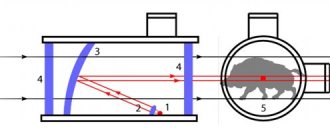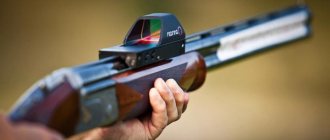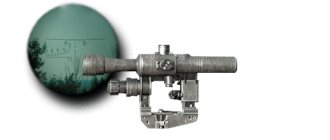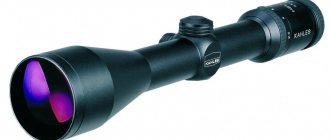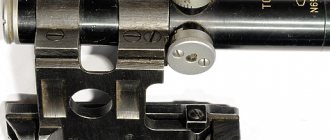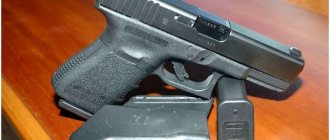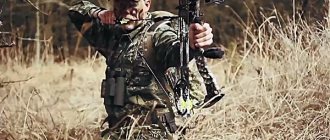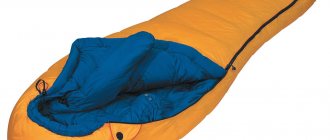How does a collimator sight (CP) work?
“I direct in a straight line” - in Russian this idiom sounds like a sentence. But the ancient Latins used only one word - collineo. And it became the basis of the scientific term “collimator”. In essence, it is a device that allows you to obtain a certain beam of light. The one in which all the particles are parallel to each other. At one time, a new type of sight was invented based on a collimator. Military pilots had something similar in their arsenal back in the First World War. We are talking about an extremely bulky structure that weighed at least 2 kilograms. For some time, the already reduced know-how was used by the special forces of various countries. The miracle spread to other branches of the military... Today, a collimator sight is available as a component of a hunting rifle. And it quickly gained popularity, since at night it looks like a harmless analogue of engineer Garin’s hyperboloid - that is, a laser.
A collimator sight consists of a light source and a lens that reflects light beams in a special lens. The resulting mark is sent in a straight line to... infinity. No matter how far the optics itself shows, the front sight will be visible exactly in the middle of the viewing circle. Simply put, collimator sights free the shooter’s pupil from the obligation to be on the optical axis of the sight, as in the case of using a lens with a scale and, moreover, a regular front sight at the end of the barrel.
History of red dot sights
The first red dot sight was created by Irish optical instrument designer Howard Grubb in 1900. Howard Grubb was the head of the Grubb Telescope Company, which was engaged in the production of large telescopes, telescope controls, and periscopes. The result of the company's design developments was the creation of the world's first collimator sight.
In 1901, Grubb upgraded his sight, making it more compact in size, allowing it to be mounted on handguns. The illumination of the aiming mark of the sight was carried out due to the illuminator, which was located on the front side of the sight; the incident light from the illuminator fell on the transmitting mirror, from it onto the concave lens into the eye of the observer.
In 1918, collimator sights began to be used in aviation and were installed on fighter aircraft. The first aircraft equipped with collimator sights were the Albatros DV and Fokker Dr.1 fighters. The sights for these aircraft were made according to Grubb's patent; electric light was already used to illuminate the aiming reticle; otherwise, the principle of their operation remained the same.
In subsequent years, collimator sights began to be widely used in aviation, anti-tank artillery, mortars, and anti-aircraft guns.
After the end of World War II, red dot sights appeared designed for use on hand-held firearms: rifles and shotguns. The most famous among them were Nudar shotgun sight and Giese electric gunsight. The Nudar shotgun sight was produced since 1945; its design was based on a translucent curved mirror that reflected light to illuminate the aiming mark. The Giese electric gunsight was produced since 1947 and was equipped with an electric battery to illuminate the aiming mark.
In subsequent years, red dot sights continued to be improved; in the 70s of the last century, the Weaver Qwik-Point and Thompson Insta-Sight sights were released. Both of these scopes used ambient light to illuminate the reticle.
A major breakthrough in the production of red dot sights was made in 1974 by Aimpoint, which was the first in the world to use a light-emitting diode (LED) to project a red dot on the target image. Now almost all red dot sights are made using this technology. Since 1975, Aimpoint sights began to be installed on American M16 rifles; they were used to a limited extent during Operation Desert Storm, where they performed well. In 2000, Aimpoint was awarded a contract to supply its Aimpoint Comp2 sights to the US Army.
Recently, the popularity of collimator sights is growing every year, a wide variety of new models appear on the market, and collimator sights are becoming available for use not only on military, but also on hunting weapons.
Types and types of collimators
The collimator sight can be open or closed. The former, being equipped with translucent lenses, make it possible to actually observe both the target and the image of the aiming mark. The latter have a light source, which is placed in a sealed (“closed”) housing. As a result, in addition to the collimator, it became possible to place another lens on the back wall of the optics - part of the eyepiece. The result of the innovation is that for the owner of a closed checkpoint, no bad weather will spoil the long-awaited event. Neither rain, nor snow, nor fog will distort the image of the aiming mark! Red dot sights are divided into categories and sizes. We have already described the first type, but the second (HUD) occupies the entire windshield of the fighter. It is complicated and, of course, has nothing to do with hunting.
In terms of combination, red dot sights are also divided into types. There are those that have attachments that turn into regular optical ones at any time. Finally, there are those on sale that, on the contrary, illuminate the reticle (for night shooting).
The best red dot sights
Pylades
Collimator sights under the Pilad brand are produced by the Vologda Optical-Mechanical Plant.
The assortment includes Pilad collimator sights of both open and closed types.
The sights are mounted on Weaver and Picatinny rails; there are models designed for installation on a ventilated rail. The sights provide adjustment of the brightness of the aiming mark.
Hakko
The Japanese company Hakko has been producing optical devices for over 40 years. Many world-class companies use Hakko as a developer and manufacturer for their optical devices, all this indicates the high quality of the company's products.
All products are manufactured at the company's factories in Japan and supplied to more than 50 countries around the world.
The company's assortment includes collimator sights of both open and closed types; everyone can choose a sight that suits them.
Eotech
Eotech colliding sights are premium products, which is why they are quite expensive. The sights are made in the USA. The company is known for being the first in the world to produce holographic red dot sights.
Many Eotech riflescope models are equipped with a night vision mode.
Aimpoint
The Swedish company Aimpoint is a world leader in the production of red dot sights. It was Aimpoint that was the first in the world to introduce its first commercial sight in 1975. The company is an official supplier to the US Army. There are over a million Aimpoint sights in use around the world. The quality of the sights is beyond praise.
Sightmark
The Sightmark company is part of the Yukon concern and produces good quality products at affordable prices. The company's product range includes collimator sights of both open and closed types. The sight bodies have a shock-resistant design and are able to withstand the recoil of any rifled and smooth-bore calibers.
Hunting with a red dot sight
When purchasing a reflex sight, you need to have an idea of all its advantages and disadvantages. This will help the lover of brutal leisure skillfully combine the CP with other optical aiming devices or abandon it in time.
Hunting with a red dot sight has a number of advantages:
- shooting with 2 eyes open: control of 2 sectors of fire, better visibility;
- to hit, it is enough to combine 2 points - the aiming mark and the target;
- the ability to use both daytime (“passive”) and “backlight” attachments;
- combination with other devices using a quick switch;
- less dependence of shot accuracy on vibration and shock loads;
- the ability to accurately show the mark even during all kinds of precipitation.
Collimator sights, according to some specialist hunters, are also associated with certain disadvantages. This is a kind of electrics - the gearbox must be “powered” from the network. And in the event of a protracted forest adventure, the charge may not be enough. Is a power bank enough? The next fly in the ointment is the high cost of the said invention. It's not for everyone. Sometimes when hunting, a red dot sight behaves very strangely. If you damage it in any way, then you won’t be able to see the aiming mark like your ears. The electronic unit, emitter and alignment mechanism require a gentle attitude... It remains to warn about one more annoying phenomenon. Gearboxes (even “closed” ones!) are prone to clogging (more often this problem manifests itself in winter - in the form of condensation formed due to a sharp change in temperature). Very delicate cleaning is required - as with any other electric optics. In general, hunting with a red dot sight is designed for those who are not intimidated by the factors presented here - who are careful, thrifty on energy sources, pedantic and relatively rich in order to afford another man’s toy.
Given the negative experience, some experienced hunters use both a collimator and a classic-style gun with a front sight at the end of the barrel. The old-fashioned method never fails.
Over a hundred years, control gear manufacturers have made a big step forward, reducing the weight, dimensions and mounting system of the device in question. But not all sellers can provide you with high-quality technological delights. Some rely on a low-cost assortment. They discover more items from the list of shortcomings presented above. As you may have guessed, red dot sights should be purchased from organizations that professionally sell the devices described in our review.
The purpose of using any firearm since its invention was to quickly and accurately hit the target with a bullet. All developments and improvements in weaponry over several centuries are aimed at increasing the speed of aiming at the target and the accuracy of the shot. So, at one time, an ordinary front sight appeared, with the development of a science called “optics” - optical sights, and with the development of electronic technologies - collimators.
Advantages of collimator sights
• The collimator sight gives a higher aiming speed, approximately 2-3 times higher compared to a traditional open sight with a rear sight and front sight, since you only need to combine two points: the luminous aiming mark and the target itself, and not three points: front sight, rear sight and purpose.
• The collimator sight gives the shooter a wider field of view compared to conventional optical sights; in addition, it allows shooting with both eyes open; this advantage is especially pronounced when shooting at a fast-moving target.
• A collimator sight, unlike an optical sight, has no parallax; when the shooter’s eye moves relative to the sight, the aiming mark also moves, constantly pointing at the target. The shot turns out to be accurate even if the shot was fired at a suddenly appearing target without proper insertion of the butt into the shoulder.
• Manufacturers of collimator sights are constantly working to improve their products; in recent years, collimator sights have appeared with variable magnification, most often 1-4x. In 1x mode, without magnification, they work like regular conventional red dot sights, and when the 4x magnification mode is turned on, they become a full-fledged replacement for optical sights, allowing you to fire shots at much longer distances.
• Some new models of red dot sights can be used in conjunction with night attachments, which brings their capabilities closer to night vision sights.
Shooting Features
After purchasing the device, you need to shoot it. First, you need to study the theoretical part, understand how the collimator sight works and how to correct its aiming at the target, and then zeroing the collimator will not cause any problems.
Installation and configuration
High-quality branded devices are provided complete with mounts for two mechanisms - dovetail and Picatinny rail. Small arms are also manufactured with appropriate mounts on the body, therefore, installing the device on the barrel consists only of firmly fixing it in the right place by tightly tightening the clamping screws. They need to be tightened tightly, but moderately, so as not to break the thread.
Before shooting a red dot sight, you need to carry out its initial setup. Setting up is not particularly difficult; any hunter can figure out how to set up a red dot sight. In expensive models, you can adjust not only the brightness, but also the shape of the front sight. Most often, the choice is between a dot, a cross, a circle with a dot, and a cross with a dot. Brightness is adjusted depending on the lighting.
In the dark, you should lower the brightness level of the light flux so as not to illuminate the target.
At the same time, there is no need to be afraid that the point in the sight will be seen by the enemy located on the other side of the weapon, because the visible beam of light is very weak and is reflected in the direction of the shooter’s eye. Thanks to this device, the front sight is visible only to the person looking through the sight, and to no one else.
Operating principle of a collimator sight
The device received its name from the principle of collimation used - the transformation of light beams that correspond to objects of observation into parallel rays. An aiming marker is located in the same plane as the objects of observation (focal plane, opt.), the glow of which is provided by a working LED.
The shooter's eye observes the marker at an indefinite distance. It never blurs and stays on target. The light source is not visible from the target side, which is explained by its low intensity and the reflection of most of the rays in the direction of the shooter.
The advantages of a collimator are the ability to aim with two eyes. This expands the field of view and allows you to move the midpoint of impact in time.
Video review of a collimator sight, its principle of operation and application:
There are open and closed collimator sights. When using the open type, the shooter observes the target with both eyes, while simultaneously fixing the aiming marker. The sight cavity is translucent, which also makes it possible to aim with one eye, as in the case of an optical sight.
When aiming a weapon equipped with a closed collimator, one eye observes the target, and the other fixes the aiming mark. You cannot aim with one eye, since the space behind the optics is made of opaque material.
Selecting a position and distance
To shoot a weapon with any scope, you need to ensure a calm atmosphere in the place where the shooting will take place. Ideally, there should be no wind or precipitation, and there should be no places with changes in humidity, such as flowing rivers, near the bullet’s flight path. Zeroing a collimator sight begins with shooting at targets located at close range. With each adjustment step, the distance to the target can be increased.
Target selection
For zeroing weapons with a collimator, targets are selected depending on the type of weapon. For the first stages of zeroing, it is preferable to choose large targets, since the error before zeroing can be very high. When using firearms, dense targets for shooting live ammunition are suitable, and when shooting from pneumatic weapons, thin targets for pneumatics are sufficient.
Red dot sights: a critical look
The problem of tuning is increasingly capturing the minds of most gun owners every year. Grips, stocks, target designators, sights, countless additions and accessories. Having immersed yourself in this world, you involuntarily remember the brilliant marketing trick with the Barbie doll. They started making and selling dolls hundreds of years ago, but the idea of making people buy a house, a horse and a life partner really revolutionized the industry.
The craving for weapon tuning is international and knows no boundaries.
Naturally, weapon tuning is not just toys. Most items have a clear, clear purpose, but this fact often disappears under a hail of arguments “it’s so cool!”, “I saw this at Alpha!”, “what if it comes in handy” and “well, I don’t know, it seems more convenient for me.”
It is in no way possible to describe all the variety of tuning in one article, so today I would like to touch on just one point - red dot sights. Opinions are particularly polar on this issue. One group of experts says that modern weapons are unthinkable without a collimator sight, and that only with it can one shoot quickly and accurately. Another group, with no less enthusiasm, claims that the red dot sight is a creation of the devil, or at least of the American intelligence services, created solely to break the combat readiness of our army in the coming confrontation with the soulless West.
One of the leading specialists of the second group, a brilliant speaker and gifted writer, went further in his rhetoric. In a personal conversation, he argued that “with a collimator sight it is impossible to get anywhere,” since a collimator sight is nothing more than a front sight and rear sight, brought together and painted red... It was logical in that situation to invite the speaker to stand up to the targets and be subjected to fire from a machine gun, but I restrained myself because I was visiting and on important business.
Of course, the opinion of such recognized authorities should not be questioned.
But I will still express my non-expert opinion based on personal experience.
First, you need to understand why a red dot sight is needed and what its real advantages are. Usually, to the question “why do you need a collimator?” people answer “you can shoot faster with it.” This is not entirely true. The competitive practice of the sport “practical shooting” is an excellent measure of the speed and accuracy of shooting. If you analyze the protocols of carbine competitions, look at how “standard” and “open” class shooters go through the exercise, and shoot in both classes yourself, it will become obvious that the difference in shooting speed, especially at short distances, is very small.
Why then do you need a collimator sight? The answer to this question appears when you have to shoot far from a clean and beautiful, well-lit army shooting range, with neat trenches and orderly rows of lifts stretching into the horizon.
1) Shooting in conditions of limited visibility.
I remember my first “awareness moment” on this topic many years ago, when I had to shoot a machine gun at night for the first time. Seven years of bullet shooting, the Moscow team, a bunch of medals - all this ceased to matter at one moment when I realized that I couldn’t see the front sight, and the target was barely visible, and only if I didn’t take my eyes off it.
Of course, you can tie an entirely white thread to the front sight, coat the sighting devices with luminous nail polish, look for the infamous radioactive attachments, or, as the manual recommends, look for bright spots on the battlefield so that, as the official manual recommends, “point the machine gun close to the target.” on a light background and take an even front sight, then, moving the machine gun, place the aiming line in the middle of the silhouette and open fire.”
But a collimator sight solves this problem more effectively. Focus on the target, a simple aiming mark is clearly visible in the dark. Test firing shows time after time that with a collimator sight, trainees are much more effective at hitting all types of targets in conditions of limited visibility - and you don’t need to be an academic to understand why. Of course, in complete darkness, an infrared laser and night vision devices will be more effective, but this is a topic for another discussion.
2) Shooting at moving targets.
All experienced instructors know how difficult it is to organize training sessions involving shooting at moving targets. There are few engines with lifts at shooting ranges, they are far away and work poorly. Homemade structures made from matches and acorns are unreliable and often fail. But radio-controlled robots, as usual, were not delivered, and the authorities are twirling their fingers at the proposal for such a purchase. They use radio-controlled cars taken from sappers, tracked robots and the most ancient mechanism - a target on a stick, which is waved by an instructor or an unlucky employee.
Several years ago, at small competitions for regional special forces, they managed to build one moving target. And again I remember the moment of sudden awareness of the scale of the problem, when both I and well-trained employees missed over and over again, not believing the mistakes themselves. It is clear that after a little training everyone began to hit, but we cannot ignore the fact that we shoot at moving targets unacceptably little.
But here the collimator makes the task easier again. We fix our eyes on the target, instantly set the aiming mark - the result usually does not keep itself waiting. Of course, you can get there with mechanics, the question is the amount of time spent on training.
3) Shooting from awkward positions.
Combat shooting, as you know, is characterized by the fact that the shooter also wants to live. That’s why you need to shoot from behind cover. Breaks in the walls, from under a car, between the wheels of an armored personnel carrier. It is not always possible to ensure an ideal insert and clearly see mechanical sights. Several years ago I had the opportunity to learn from American instructors. I went to a distant country for a tactical course, and so... We work in pairs, cover each other, retreat, the command sounds - shoot from behind the car. I grin internally, thinking, “right now I’ll show them how to do it, I’ve done it a thousand times,” I fall on my side, take cover behind the wheel and suddenly realize that I’m aiming exactly at the threshold of the car. And again the “moment of realization” - every time before in Russia I shot from under an SUV, and here it’s a rotten sedan with sagging shock absorbers, whose ground clearance is two times less. I had to wriggle out - the machine gun landed on the concrete, I bent over, craned my neck, I saw a dot on the very edge of the sight, I shot.
In such conditions, the presence or absence of a red dot sight determines whether you will, in principle, be able to make an aimed shot or not.
The photo shows the author of the article before meeting the rotten sedan.
The weapon is too high to fire from under a regular car, even if you change the shoulder. 4) Training of novice shooters.
The analogy here is very simple. A collimator, like an automatic transmission, makes the initial learning process much easier. Instead of jerking gears and squeezing the clutch, you simply engage “drive” and turn the steering wheel. It's the same with shooting. Instead of the mysterious rear sight and front sight, the conscript of the Call of Duty generation sees a red dot and can calmly learn to work with the trigger and other aspects of initial shooting training. Then, of course, it is imperative to teach a person to work with mechanics, without this he simply will not be a shooter, but the collimator simplifies the initial training.
It's the same at work. I remember during my first business trip as part of a PMC we were given four machine guns, only one of which had a collimator. After some consultation, the most fashionable machine gun was given to the least experienced employee, because the rest seemed to be able to cope, and the collimator, obviously, would help compensate for the lack of skill.
The same machine gun
It was because of these many “realization moments” that I came to believe that a red dot sight was a necessary and important thing to use. “What kind of crap is this?”, the attentive reader will ask. Why then is the article called “Collimator sights - a critical look.” This is just another traitor-sub-pindossian advertising enemy toys, which the enemies will turn off from the satellite, but if they don’t turn off, they will burn them with electromagnetic radiation!!!” “Wait, wait,” may I answer the attentive reader. We haven't gotten to the most important part yet. Namely, until the moment when dreams about collimators are often tragically broken into reality. And that's why.
For a red dot sight to be effective, three factors must be met. a) The sight must be of high quality. b) The sight mount must ensure that the MTP (average point of impact) is maintained in all conditions. c) The shooter must know the ballistics of the ammunition and understand where he needs to aim at each distance.
And the sight is the best, and the mount seems to be reliable.
One problem - the collimator is backwards. Let's look at each point in more detail.
a) The sight must be of high quality.
As fate would have it, I had to use a lot of different sights. A high-quality sight, in my understanding, works on one battery for several years, withstands all the same survivability tests as a weapon (throws from a height, +50, -50, shooting the full life of a weapon in extreme modes, and much more). Therefore, my rating of quality sights looks like this: 1) Aimpoint 2) ... 3) ...
It so happened that I watched Aimpoint scopes go through full, qualified testing along with the weapon over the course of eight months. Deserts, mountains, snow, dirt, freezing, shooting for resources and much more. There was an opportunity to communicate with company representatives, work together and learn more deeply about how sights are created, manufactured and tested. The approach to each stage is impressive. For example, Aimpoint will soon release a new scope. But they don't take it to exhibitions. They take it to trials all over the world, testing it in complete secrecy to make sure that the product turns out without flaws.
But Aimpoint also has disadvantages. More than once my batteries died much earlier than the promised five years. With the Micro T-1, the STP significantly decreases depending on the position of the sighting point relative to the edge. This effect is perfectly described by M. Degtyarev in the Kalashnikov magazine 11/2015. The next model, T-2, no longer has this effect.
Trijicon MRO has appeared recently and there are not enough statistics yet. I haven't tried RMR on slot machines.
I haven't liked EOtech for a very long time. Especially hard after the new EXPS2 with a fresh battery simply died on my AK 103 when firing in bursts. It was fun. Athletes have always complained that the brand fades over time. For several people it simply broke: https://karden.livejournal.com/38405.html#comments
And then came the day of reckoning for EOtech: https://soldiersystems.net/2015/09/30/ussocom-issues-safety-use-message-eotech-enhanced-combat-optical-sights-plus-goings/
This wonderful phenomenon was not particularly noticed on the Russian Internet, so I’ll tell you about the details. First, the US Special Operations Command issued an official warning about the problems with these sights. With a serious change in temperature, the STP moved by 5-6 MOA. The manufacturing company dealt with this in a very interesting way - they removed information from the instruction manual about what temperatures the sight was designed for. As a result, the manufacturer paid a fine of 25.6 million to the state, and ordinary civilians are sending their sights to the manufacturer by the carload for a refund.
All details here: https://www.eotechlawsuit.com/
And even if this did not happen, the Eotech itself is relatively heavy, the operating time on one battery is insufficient, and it is extremely difficult to ensure alignment with mechanical sighting devices.
Holosun products have been performing very well lately, but they have not yet gained the necessary credibility. So far, tests show excellent operating time and excellent reliability, but it is psychologically difficult to gain confidence in a Chinese sight.
b) Sight mount. Welcome to the unique and amazing world of hundreds of clever devices designed to mount optics on AKs. This topic itself deserves a separate dissertation, so we will consider only the most general points. The problem of mounting optics is actually not unique. Owners of Czech VZ 58, old G-3, FN FAL, and, in general, all weapons from the Cold War era experience the same problems.
Realistic options for rifled weapons are as follows: 1) On a gas tube (receiver plate) 2) Instead of an aiming bar 3) On the receiver cover 4) On a side bracket
1) On the gas tube (barrel lining)
The most deserved option here, of course, is the gas tube from. A small company, with an awkward website, from the barely visible city of Moscow, Idaho, has created one of the most effective ways to attach collimators to a Kalashnikov assault rifle.
Everyone knows the advantages - STP does not go away, the weight of the weapon practically does not increase. If the collimator fails, mechanical sighting devices remain visible in its lower part, which allows you to continue targeted shooting.
The disadvantages are also obvious. Not every sight can be comfortably mounted on a gas tube; it will have to be cleaned without removing it. The “scout” scope mount is far from the eye and is not convenient for everyone. And most importantly, the gas tube inevitably heats up, heating the collimator. Depending on various factors, this can lead to malfunction of the scope.
Various handguards—thousands of them—have the same set of problems. Not all of them have sufficient rigidity and almost all of them are slightly taller than the Ultimak and its copies, so the rear sight and front sight are no longer visible through the installed collimator.
2) Instead of an aiming bar
We are talking about “Nomad” type planks. A very interesting and logical solution. Mounting the sight on the sighting rail block makes sense - this part is not removed during disassembly and is fixed to the barrel and the front receiver liner. The sights are attached securely, the STP does not go away.
The problem with such a mount is obvious - the shooter deprives himself of the opportunity to use standard sighting devices. For sports this is not a problem, for other situations it is a reason to at least think very seriously.
3) On the receiver cover
It seems most logical to install the sight somewhere in the area of the receiver cover. But, as we remember, the AK cover is removable, and often has a backlash. I met a group of specialists at one military-industrial complex enterprise who claimed that this was not a problem at all and simply welded the picatinny rail onto the standard cover. It's an interesting concept, but in general most people want something more durable.
There is no universal, uniquely proven solution in this area yet. The Zenit cover shows itself well, but to install it you need to install a handguard, which, for example, I don’t need at all. The cover from FAB Defense looks interesting, but no one has yet seen the results of full-scale, long-term trial operation. New versions of kits from CAA look promising, but the price is stopping many.
Polar opinions are expressed regarding the Texas Dog Leg. For some, it doesn’t hold fire at all, while others swear that the human mind has not yet created anything better. But if we look at things objectively, by installing this cover, we are again completely deprived of the standard rear sight. Wouldn’t it be easier then to install one of the “Nomad” options, which costs six times less?
4) On the side bracket
Actually, the only option provided by the manufacturer. This is its main advantage. No modifications, hours of file work, and frowning looks from your superiors trying to figure out what you did with your service weapon.
The disadvantages of the side bracket are obvious - the weight of the weapon increases, the butt cannot be folded, the side bars on machine guns often play, and not all machine guns have them. Now there are many manufacturers of brackets on the market; there is no point in listing them all.
In general, the meaning is very simple - if you do not have a reliable and proven sight mount on your weapon, the best collimator will not only be useless, but harmful. The sudden departure of STP is a very unpleasant event, akin to unexpected sexual impotence.
c) The shooter must have excellent knowledge of the ballistics of the ammunition and clearly understand where he needs to aim at each distance
Let’s assume that the stars aligned in such a way that you got your hands on a high-quality scope, you reliably installed it on your weapon, shot it, tested it according to your program and were completely satisfied. Great. The last thing left is to shoot the scope at all distances and understand where you need to aim at each of the possible distances.
Ballistics and shooting are the topic of at least a separate article. Just remember that until all your colleagues understand where they need to aim at 25, 50, 100, 150, 200, 250, 300, 350, 400, 450 and 500 meters, the shooter-weapon complex with a red dot will be less effective than shooter with a conventional machine gun.
Only if all three factors are observed, namely: a high-quality sight, reliable mounting and complete knowledge of the ballistics of ammunition, will you achieve an increase in fire efficiency. And if you ignore any of these points, the collimator on your weapon will not even become useless, but simply a dangerous toy.
The shooting process step by step
Zeroing occurs in several simple sequential stages.
- Before zeroing the collimator, you need to place the weapon in a stable position so that the swinging of the shooter’s hands has as little effect as possible on the shooting accuracy. You can use a stop in a stand, or fix the weapon very tightly in a vice with soft linings.
- The weapon is aimed at a target located 10 meters from the shooter.
- Fire 3 shots.
- Based on the shooting results, a deviation of the bullet trajectory from the aiming point is observed. Using the appropriate screws, the collimator sight is adjusted and the position of the marker is adjusted.
- Fire 3 more shots.
- If the shooting results are acceptable, then the target is moved to a distance of 30 meters.
- Shooting is repeated and adjustments are made in accordance with the shooting results.
- When the accuracy of shooting at a target at a distance of 30 meters becomes satisfactory, then the target can be moved to a distance of 100 meters.
- The process of sighting and adjustment is repeated again until satisfactory accuracy is obtained.
When shooting at close and long distances becomes sufficiently accurate, zeroing the red dot sight is completed.
Installation
Modern sight mounts (brackets) have two main mechanisms - dovetail and Picatinny rail. The most expensive models can be fixed to any of them, thanks to the universal mounting kit.
When installing the sight, its location is rigidly fixed with clamping screws, and sometimes additionally locked in a special groove. Tighten the screws firmly, but carefully so as not to strip the threads or bend the guide strips.
The installation of a collimator sight on a rifle with an adapter bar can be seen in this video:
Cold shooting
In addition to the usual shooting method, there is also the so-called cold shooting. It happens without a single shot being fired. To do this, a special tube with a laser is inserted into the barrel of the weapon, which is directed exactly along its axis.
As a result of using such a device, a laser marker appears that points exactly to the point at which the barrel of the weapon is pointing. This is the point of impact of the bullet without taking into account the decrease in its trajectory during flight.
After installing the guide laser, the position of the marker is adjusted to the laser marker, taking into account the lower trajectory of the bullet. After this, the device can be considered zeroed, but for reliability, you should still check the accuracy of the weapon with live ammunition after it has been cold zeroed.
Types of collimator sights
To choose the right collimator, you first need to understand what variants such sights come in. First of all, you need to consider that not every model uses LED backlighting. Therefore, according to the principle of action, all their diversity can be divided into 2 main groups:
- active;
- passive.
Active options are precisely those models that use an artificial light source, in other words, an LED. Their main feature is that the mark is always visible when the sight is on, regardless of the light intensity. The LED element takes energy from an external power source, it can be a regular battery or accumulator.
This is certainly the most advanced type of collimator, however, it also has its limitations. First of all, it is dependent on external power. Therefore, every time you go to the shooting range, you need to make sure there is a sufficient charge level. Otherwise, the battery may run out at the most inopportune moment. To be even more confident that the equipment will not let you down, you should choose a model with the ability to replace the battery without removing and then reinstalling the collimator on the gun. Recharging the battery is extremely easy here, so you won't lose sight of your target. Another feature of active sights that will have to be taken into account is their lower resistance to low temperatures.
Passive collimators are self-contained sights that operate without external power sources. In other words, the aiming mark is formed from the daylight collected by the lens. We have already discussed all the disadvantages of this concept above, but the main one is the high sensitivity to the level of illumination.
According to the method of aiming, collimators are divided into through and stereoscopic, they are also blind. The first allow you to aim with one eye or two at the same time. The second requires aiming with only two eyes.
Open or closed collimator?
The division into open and closed is perhaps the most important basis for classification. The first design option provides only 1 lens, and the light element is placed on the base of the sight between the lens and the shooter. This configuration has the following strengths:
- an increased lens area and a relatively thin frame, which provides the shooter with a greater overview - and, therefore, makes it easier to shoot at moving targets;
- relatively lower weight and dimensions make it easier to balance the gun;
- The price for such sights is lower than for closed ones.
But open models also have serious disadvantages. Firstly, it is minimal protection from external influences. Dust, dirt, and water may get on the lens, causing the image of the brand to be distorted. Secondly, the lens of the light source may also become dirty, causing the sight to become inoperable. But cleaning the LED window efficiently and accurately in the field will not be easy. In addition, a number of open models are sensitive to external light.
A separate type of open collimators are models that use the hologram principle. What is the difference between a regular red dot sight and a holographic one? First of all, because it uses not the effect of reflected light, but a laser. It creates a hologram that is projected onto a special surface. The latter, unlike traditional models, does not have any darkening coating. In addition, the parallax effect is least pronounced in holographic collimators. The main disadvantage of such devices is increased energy consumption.
Closed sights are similar to optics with their cylindrical body. There are two lenses here - the front objective and the rear ocular. The light source is located inside a sealed housing between 2 lenses. The light point is focused onto the rear lens. The main advantage of a closed configuration is protection from external factors to which open models are exposed. However, it is larger and heavier, and the viewing angle in this case is reduced. Due to the less pronounced parallax effect, closed red dot sights are best suited for rifled weapons. Open analogues are best used on a smoothbore for shooting at short distances.
Brief overview of models
There are several well-known manufacturers producing collimators. Each brand has its own characteristics, advantages and disadvantages.
Cobra
A Russian manufacturer that specializes primarily in open-type models with the ability to adjust the brightness and type of marker. The differences between the models are mainly in the method of fastening.
- EKP-8-02 is fixed on the barrel using a side mounting system with movable levers located in hidden places to minimize the possibility of accidental pressing.
- EKP 8-18 has a different mounting method - a Picatinny rail.
- EKP-1S-03 is a device with a side sighting bar, the arrangement of the locking levers of which ensures maximum ease of installation and removal.
Eotech
American manufacturer with a good reputation. Devices of this brand are common among the military and tested in combat conditions. The high quality of these products corresponds to their high price. The manufacturer specializes in open sights of compact size and are mounted on a Picatinny rail as standard.
- Eotech 552.A65 is a standard model with good moisture protection and customization options.
- Eotech EOLAD-1V - has a laser designator built into the design, making it easier to fire from the hip.
- The Eotech XPS3 is a very compact model and is completely waterproof.
Aimpoint
Manufacturer from Sweden. The range of this brand includes many models for various purposes, both sights for military special forces and for hunters. Available with various mounting systems, allowing installation on almost any weapon. The quality and price are very high.
- The Aimpoint 9000L is an enclosed long sight for hunters. One of the most common models due to its versatility with multiple brightness levels, water resistance and resistance to mechanical damage.
- Aimpoint CompC3 is a closed model with a more compact size, more suitable for medium and close ranges.
- The Aimpoint Micro T-1 is a compact device used primarily on short-range shooting weapons.
How to choose a red dot sight
How to choose a red dot sight
There is an unspoken rule - all red dot sights with a purchase price below 15 USD. That is, they are not fully sights. This is due to the extremely unreliable design of cheap crafts, which will go astray at the slightest shock (even when reloading).
If the scope is selected for a maneuverable melee weapon (for example, a pistol), you may want to consider installing a closed scope, which will be more durable. When using a rifle, an open collimator in a long body is suitable, allowing you to aim even at long distances. An open red dot sight with a single lens in a frame (without a massive body) is equally well suited for maneuverable rifle and pistol shooting. It’s best to read reviews about a particular brand in popular online stores before purchasing.
Video
Watch our video on how to sight and adjust a red dot sight using the Aimpoint Micro T-1 model as an example.
Conventionally, hunting sights can be divided into two categories: purely mechanical devices and devices based on effects in optical glass - prisms and lenses. The first includes open and diopter sights, the second includes collimator and optical sights. The latter, due to the huge species diversity, deserve separate consideration; there are a good dozen main types of meshes alone.
Disadvantages of red dot sights
Collimator sights also have some disadvantages:
• The collimator sight contains electronic components that, under the influence of water, humidity or shock, can fail at the most inopportune moment, leaving you virtually unarmed.
• Most modern red dot sights are powered by batteries or rechargeable batteries; the hunter has to constantly monitor their charge; it is also advisable to have an additional spare set of batteries with him when hunting.
• Collimator sights, even closed ones, tend to clog the emitter; this often happens in winter, due to the formation of condensation in the sight, with a sharp change in ambient temperature. To eliminate this problem in a difficult case, the red dot sight requires careful cleaning.
• High-quality red dot sights are not cheap.
Collimator sight
Collimator sights, despite the sufficient complexity of these devices, are similar to open devices in their area of application, covering short shooting distances, in particular, in driven hunts. There is also no magnification of the image, adjustment of its magnification, or dioptric adjustment to the specific vision, which is typical for most optical sights. But the wide field, lack of parallax, and the ability to change the viewing angle make them an excellent option for shooting at moving targets.
Collimators are divided into passive, which do not require a power source, and active, in which the aiming mark in the form of a bright dot is additionally illuminated and does not depend on the level of external illumination. To aim, it is enough to align it with the target, while the angle of view is completely unimportant, the main thing is not to lose sight of the target.
When the pupil moves, the aiming mark also visually moves, but in reality remains at the aiming point. Which makes the shot accurate even when an animal suddenly appears and shoots without the correct insert.
Collimators are of open and closed types. The open one has only one lens, and the light source is located at the base.
They are characterized by excellent visibility, low weight and dimensions that do not interfere with the weight distribution of the weapon.
A special type of open collimators are holographic sights, in which a hologram located on a special reflector acts as a mark.
With higher accuracy of these devices, they are subject to a kind of “flash” of the image from bright light sources. In addition, they cost significantly more than their counterparts.
In a closed collimator, the light source that forms the mark is located in a sealed housing and, in addition to the front lens, there is also an eyepiece.
Among the main advantages is the ability to withstand environmental influences. Expensive devices from well-known manufacturers are initially designed for harsh operating conditions.
The image of all three types of collimators is also formed differently.
In recent years, the capabilities of red dot sights have expanded even further. Thus, devices appeared with variable magnification, usually 1-4x. In the basic mode, they act in their usual role; when the magnification is changed, they turn into an optical sight-driver. Some models can work with night monoculars, which brings their capabilities closer to much more expensive NVGs.
Features of the red dot sight
The fundamental technical difference between this model and other types of sighting devices is that it does not have a permanent front sight or reticle. Aiming is based on directing a beam of light into the shooter's eye using a lens, which is compared with the target and gives very accurate guidance to the target.
With a slight deviation of the weapon along the horizontal or vertical axis, the mark also moves, still indicating the direction of flight of the bullet. Such qualities are unimaginable for other types of sighting devices.
Principle of operation
The design of a collimator sight involves the use of simple electronics and optical effects. The light source is directed into a reflector lens, which generates a stream of light in the direction of the shooter. A person holding a weapon in a firing position sees this flow in the form of a point, which moves along the lens depending on the displacement of the weapon’s axis relative to the shooter’s axis of view and makes it possible to quickly and accurately point the weapon at the target to fire a shot.
The collimator takes advantage of human binocular vision, giving the shooter the ability to aim without covering the other eye.
Difference from other types of sights
When using a standard open front sight, the shooter must align his gaze, the front sight on the nose of the barrel and the rear sight on its near edge on one axis before firing. Only when these conditions are met can the person firing the shot be sure that the bullet from the barrel will fly in the right direction. This method reduces mobility during shooting and visibility, since the shooter needs to close the second eye so that binocular vision does not interfere with accurate targeting.
When using an optical sight, shooting while moving is almost impossible due to strong vibrations of the mark. High shooting accuracy in this case is achieved by a stable position of the weapon, in which it is possible to point the crosshairs at the target. For such measured shooting, only conditions of large distances between the shooter and the target are permissible - the conditions of sniper shooting.
This device allows for accurate shooting at close and medium distances. All that is required is to combine the direction of view and the light flow, after which the shooter sees where the bullet will hit. Compared to a conventional open sight, a red dot sight, whose operating principle allows you to spend a shorter period of time on aiming, gives more space for accurate shooting while moving.
In conditions of long-distance shooting, the collimator does not allow accurate shooting, since the marker can cover almost the entire target, so it does not compete with sniper optical devices.
An important difference between a collimator and other devices is the use of electricity for operation. Without power, the light source will stop working, making accurate aiming impossible. Therefore, when using a device of this type, you should remember that it works until the battery runs out.
Application
Since their appearance, red dot sights have spread to many areas of human activity related to weapons. Besides military and police units around the world, they are most common among hunters and airsoft players. In some cases, the collimator is even placed on the bow.
This device is suitable for almost any type of small arms intended for close and medium ranges, including heavy shotguns and even machine guns. So what is a red dot sight for? Shooting in combat conditions or regular hunting with a collimator sight will definitely become easier and more convenient after you get used to it.
Types of collimators
Collimators are divided into open and closed. Initially, these classes meant two types of collimator sights, significantly different in their structure.
Closed devices in the classical sense were those that did not have a transparent lens. Through it, the shooter did not see the space behind the sight with the eye that sees the front sight.
Aiming was achieved by the need to use two eyes at once, one of which sees the space ahead, and a mark is projected onto the second by a collimator. Thanks to binocular vision, the human brain in this case compares different images from two eyes and the shooter sees the front sight in front of the target and can take aim.
Open was a model with a transparent lens and an open front wall. Through such a sight the target is visible. Therefore, shooting with a collimator sight using only one eye is possible only with an open type.
With the development of collimators, the need for closed sights in the classical sense has disappeared. There is a new understanding of the difference between closed and open devices. Nowadays, an open sight is a sight in which the lens is fixed in a small frame and does not have an auxiliary protective structure around it.
A closed device is a device in which the focusing lens is located in a sealed structure consisting of a massive frame and an additional front lens. This design protects the focusing lens from raindrops, dirt and other foreign objects that can spoil the quality of aiming. It is precisely this understanding of the concepts of closedness and openness that is widespread at the present time.
Operation, care, storage rules
To ensure that a high-quality collimator does not fail during shooting, you need to install it only on weapons with the appropriate caliber. The device, intended for pistols and light semi-automatic weapons, cannot be installed on weapons with high recoil, as this can quickly disable it.
It is quite easy to damage this device. The lenses do not withstand any physical impact well; they are easily scratched, which reduces the quality of aiming. It is better to wipe them from dust using special napkins and without using improvised means, as some fabrics can leave scratches.
Batteries are inserted into the device only before shooting and removed after shooting. When storing weapons, batteries must be kept separate to protect the electronic parts of the device from possible damage if the batteries fail.
It is also advisable to remove the device while transporting the weapon, or use special cases that protect it from possible physical impact.
How to choose?
When choosing, first of all you should know what caliber weapon it will be installed on.
When choosing from models designed for weapons of a suitable caliber, you need to understand that cheap options are not complete and reliable, and will go astray during shooting and sudden shaking. A stable and reliable design can only be expected from well-known and time-tested manufacturers, so you cannot save money here. A cheap device will quickly break down during active use and you will still have to purchase a new one, therefore, it is better to immediately buy a more expensive but reliable one.
The choice between an open and closed device is based on the conditions in which it will be used. For mobile shooting at close distances, where there may be an unexpected physical impact on the device, impacts, or pieces of earth falling into it, it is better to purchase a device of a strong, closed design.
For installation on rifles intended for long-range shooting, you can choose an open collimator suitable for such weapons, but a closed one is also suitable, since the viewing angle in this case does not play an important role.
Sniping is not possible with a standard device, but there are options with lenses that provide some proximity for more convenient long-range shooting.
What types of collimator sights are there?
Depending on the type of operation, collimator sights are divided into two types. Active collimators operate on batteries. The brightness of their aiming mark does not depend on the time of day. Passive sights require sufficient illumination. It is this that determines the glow of the brand.
Open
Features of open collimators:
- cannot be used during snow and rain, as they do not have protection from weather factors;
- have the function of changing the aiming mark;
- lighter and more compact than closed ones;
- provide sighting with two eyes;
- do not obscure the field of view.
Closed
The difference between closed type sights is the presence of protective glass (4) and a housing on both sides. The optical design is the same as that of open collimators. Protective glass protects the device from weather conditions and prevents dirt and moisture from penetrating inside.
Features of closed sights:
- in addition to the front lens, they have an eyepiece lens;
- due to the body, the aiming area is obscured;
- more dimensional;
- When installing an additional optical attachment, the magnification of the sight increases by 2 times.
Holographic
When deciding how to choose a collimator sight for a smooth-bore weapon, it is worth considering holographic models. Outwardly, they are similar to open sights, but have a different operating principle. A laser beam with a recorded image of the brand is emitted onto the photographic plate (1) from the reference radiation source. The result is its holographic projection (3). The image can also be obtained using a holographic grating (6) and a collimating reflector (5).
Features of such collimators:
- holography is better perceived by the human eye in daylight and night lighting;
- the brand is visible regardless of the degree of illumination;
- have virtually no parallax errors.
Pre-setting the front sight
No matter how you use the gun, for example, offhand, as well as in a prone, standing, sitting position, with a well-tuned collimator, the aiming mark should always point directly at the target.
So, before doing anything, make sure that the scope is firmly installed, otherwise it may get lost when zeroing and show different results all the time.
First, let's adjust the brightness by turning the drum. It depends on the lighting: at dusk it can be lowered, this will prevent the target from being illuminated. But whatever the brightness, it is still weak, so neither the enemy nor the animal will notice the point in the sight.
The most convenient shape of the front sight is chosen: dot, cross, circle with a dot, cross with a dot.
If the preliminary settings are made, then we proceed to adjusting the front sight.
